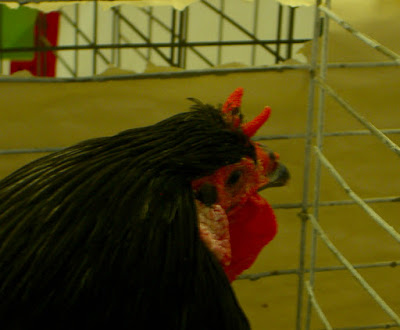chickens : Java and La Fleche
Java chickens
Java chickens thrived in the United States between
1850 and 1890.
They are an ideal farm bird as the hens are ample layers, and
the birds are tender and juicy table fare.
Java chickens come in black
and mottled colors.
They were popular
in New York and New Jersey in
the mid to late 1800s because their black pinfeathers could easily show consumers if the birds had been plucked correctly.
As the chicken industry grew, chicken
entrepreneurs decided they could conceal white-feathered birds more easily
if the plucking was sub-par.
This
practice nearly caused the Java to be driven
to extinction as there was not much demand
for them any longer, and larger chicken
breeders stopped breeding
the birds.
Despite this, the breed persevered, and small
farmers raised the Java because their dual purpose
suited their needs.
Even today, the young cockerel makes
for a good roaster, and the rich brown eggs provided
by the hens are tasty and bountiful.
Java roosters weigh about 9 ½ pounds, and Java hens
weigh about 6 ½ pounds.
They are easy to care for,
and their docile nature makes them a pleasant family pet.
These birds
have a clean leg, yellow skin, and dark shanks.
They have a single comb and red earlobes.
This bird will provide you with plenty
of food and companionship.
La Fleche chickens
Originating in France in the 1600s, the La Fleche
chicken comes from the Valley
of La Sarthe.
This breed has been around for centuries.
They come in
white, cuckoo, and blue lace, but black is the most common color, and it is the color they are most
known for among chicken breeds.
La Fleche is a hardy table bird. Males weigh
8 to 9 pounds, and hens weigh
6 to 7 pounds.
Bantams weigh
in at 3 pounds.
Although their coat is a deep black color, this breed has remarkable white meat as a table bird.
If you are looking for a proficient egg layer,
the La Fleche hen lays 180 to 200 large eggs each year.
Their eggs are white to light brown color.
As a pet, La Fleches
are not people friendly.
They are somewhat
shy, yet docile.
They are
active and thrive as free-range birds because they enjoy foraging for food.
La
Fleches move around and like to roost in trees.
You can train them to return to the coop each night by feeding
them at the same time each day. They
will be hungry and will learn that feeding time is in the evening.
This is the
easiest way to gather your flock at the end of the night.
La Fleches have a long, V-shaped wattle, and their comb has dual spikes or horns.
They have even been referred
to as the “Devil’s
Head” because of their
shape.
Their earlobes are white,
and their legs are clean with four toes.


Post a Comment